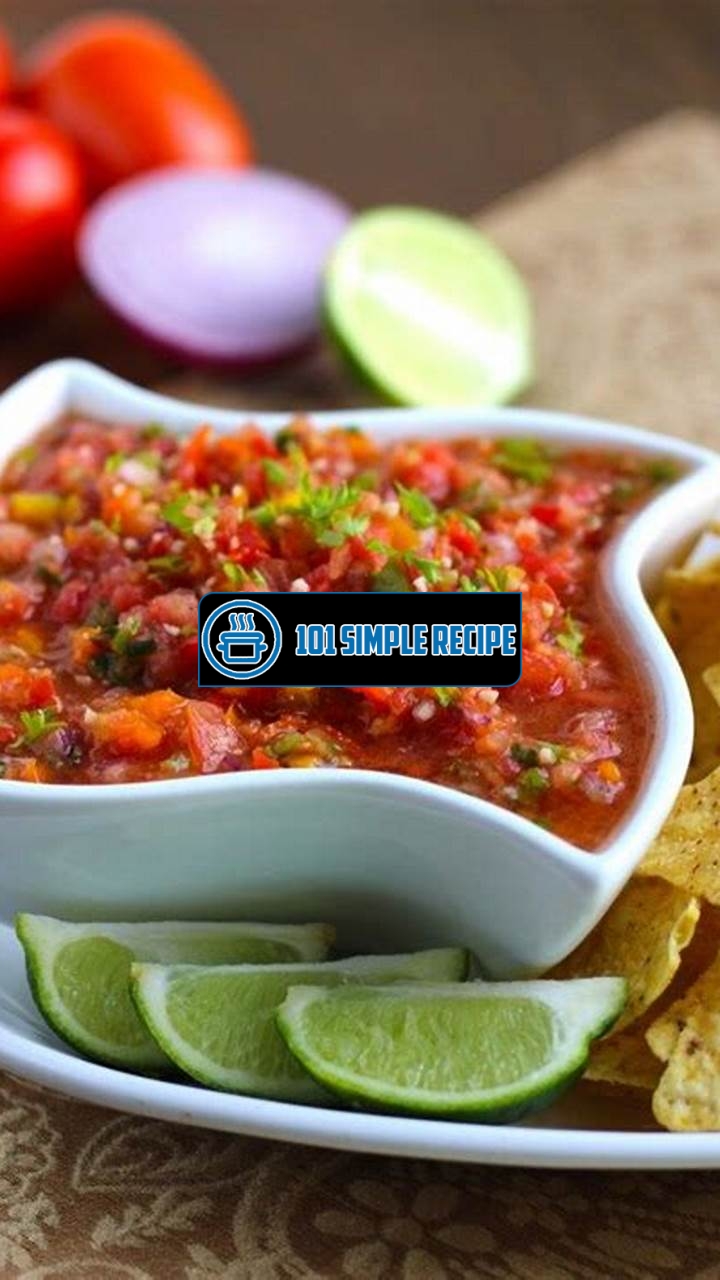Are you tired of the same old boring store-bought salsa? ️ It’s time to spice things up and tantalize your tastebuds with homemade salsa! Whether you’re a salsa connoisseur or a beginner in the kitchen, making your own salsa is an easy and rewarding experience. Not only does it allow you to customize the flavors and heat levels to your liking, but it also gives you the satisfaction of creating a fresh and flavorful condiment from scratch. So put on your apron and get ready to embark on a salsa-making adventure that will revolutionize your snacking experience!

Choosing the Right Ingredients
When it comes to making a delicious homemade salsa with cilantro and lime, choosing the right ingredients is key. Each ingredient plays a crucial role in creating the perfect balance of flavors. Let’s dive into the key components that will spice up your tastebuds.
The Freshness Factor
One of the most important factors in making homemade salsa is using fresh ingredients. Freshness ensures that the flavors are vibrant and the salsa tastes as delicious as possible. So, pay close attention to the freshness of each ingredient you select.
Start with fresh tomatoes. Ripe, juicy tomatoes are the foundation of any good salsa. Look for tomatoes that are firm and brightly colored. Avoid any with blemishes or soft spots. The freshness of the tomatoes will significantly impact the overall taste of your salsa.
In addition to tomatoes, it’s crucial to choose fresh cilantro and lime. Cilantro adds a delightful herbaceous flavor while lime provides a tangy kick. Make sure the cilantro leaves are green and fragrant. Avoid any yellow or wilted leaves as they indicate a loss of freshness. When selecting limes, go for ones that are firm and have a vibrant green color. They should feel heavy for their size, indicating juiciness.
Selecting the Perfect Tomatoes
Tomatoes are the star ingredient in a homemade salsa, and selecting the perfect ones will make a significant difference in the taste. Here are a few tips to consider when choosing tomatoes for your salsa:
- Opt for vine-ripened tomatoes: Tomatoes that are left to ripen on the vine have a richer flavor compared to those picked early.
- Consider the variety: Different tomato varieties have different flavors. Experiment with cherry tomatoes, Roma tomatoes, or heirloom tomatoes to find your favorite.
- Look for firmness: Choose tomatoes that are firm but slightly yielding when gently squeezed. Avoid ones that are too mushy or overly hard.
- Check the color: Bright red or deep orange tomatoes are usually the ripest and most flavorful.
Enhancing Flavor with Cilantro and Lime
Cilantro and lime are essential ingredients that take your homemade salsa to the next level. Both ingredients bring brightness and a refreshing twist to the flavor profile. Here’s what you need to know:
Cilantro, also known as coriander, is an herb that adds a unique tangy and citrusy flavor to your salsa. To use cilantro, wash the leaves thoroughly, pat them dry, and then chop them up finely. Keep in mind that cilantro has a distinct taste, so adjust the amount according to your preference.
Lime, on the other hand, adds acidity and a zesty kick to the salsa. Squeeze fresh lime juice over the diced ingredients and mix well. The amount of lime juice you use will depend on your personal taste and the desired level of tanginess.
By carefully selecting fresh ingredients and paying attention to the flavors of each component, you can create a homemade salsa with cilantro and lime that will undoubtedly spice up your tastebuds. So, head to your local grocery store or farmers market, gather the freshest ingredients, and get ready to enjoy a burst of flavors in every bite.
Preparing the Ingredients
When it comes to making homemade salsa, the key to success lies in the preparation of the ingredients. By following these steps, you’ll be able to ensure that your salsa is bursting with flavor and perfectly balanced.
A Pro Tip for Chopping Onions
Onions are a staple in many salsa recipes, but they can often leave you in tears. To minimize the waterworks, try this pro tip: place the onion in the freezer for about 15 minutes before chopping it. This will help to reduce the release of the volatile compounds that cause your eyes to water. It may sound strange, but it really works!
Dealing with Hot Peppers
Hot peppers are another key ingredient in salsa that can be a bit tricky to handle. Whether you’re using jalapenos, serranos, or habaneros, it’s important to take precautions to protect your skin and eyes from the spicy heat. One effective method is to wear gloves while handling the peppers. This will prevent any accidental transfer of capsaicin, the chemical responsible for the heat, to sensitive areas. If you don’t have gloves, be sure to wash your hands thoroughly with soap and water after handling the peppers.
Another helpful tip is to remove the seeds and membranes of the peppers, as they contain the highest concentration of capsaicin. By removing these parts, you can reduce the spiciness of your salsa while still enjoying the flavors of the pepper.
Getting the Most Juice out of Lime
A splash of lime juice can add a refreshing tang to your homemade salsa. To get the most juice out of a lime, roll it firmly on the countertop before cutting it open. This will help to break down the pulp and release more juice. You can also microwave the lime for a few seconds to further increase the juice yield. Once it’s warmed up, give it another roll before squeezing out the juice.
When it comes to juicing the lime, a handy trick is to use a pair of tongs. Simply place half of the lime between the tongs and squeeze, letting the tongs act as a lever to extract every last drop of juice. This method is particularly useful if you don’t have a citrus juicer on hand.
By properly preparing and chopping the ingredients for your homemade salsa, you can elevate the flavors and make it truly memorable. So don’t be afraid to experiment with different combinations and spice levels to find your perfect salsa recipe. Enjoy!
Mixing and Seasoning
Master the art of combining the ingredients and adding the perfect blend of seasonings to your homemade salsa.
A Balance of Flavors
When it comes to creating the perfect homemade salsa, achieving a balance of flavors is key. You want each bite to be a harmonious explosion of taste. To achieve this, start with the base ingredients like tomatoes, onions, and peppers. These ingredients provide the foundation of your salsa’s flavor profile.
Next, think about the seasoning. One essential ingredient is cilantro. Not only does it add a fresh and vibrant taste, but it also pairs perfectly with lime. The combination of cilantro and lime adds a zing to your salsa that will make your taste buds dance with joy. Make sure to finely chop the cilantro to ensure it is evenly distributed throughout the salsa.
In addition to cilantro and lime, you can add other seasoning agents such as garlic, cumin, and salt. These ingredients enhance the overall flavor and give your salsa that extra kick. Experiment with different combinations and ratios to find the perfect blend that suits your taste.
Note: The secret to a great homemade salsa is to taste as you go. Don’t be afraid to adjust the seasonings to achieve the desired flavor. Remember, you are the master of your salsa, and you have the power to create a unique blend that satisfies your cravings.
Experimenting with Heat Levels
For some, salsa is not complete without a spicy kick. If you enjoy a little heat in your salsa, it’s time to experiment with different chili peppers. The most common peppers used in salsa are jalapeños and serranos. These peppers provide a moderate level of heat, but if you’re feeling adventurous, you can try habaneros for an extra kick.
To determine the heat level of your salsa, consider the amount of seeds and membranes you include from the peppers. The seeds and membranes contain the majority of the heat. If you prefer a milder salsa, remove the seeds and membranes before adding the peppers to your salsa. For a spicier salsa, leave them in.
Note: When handling spicy peppers, it’s important to protect your hands by wearing gloves. These peppers can cause a burning sensation if they come into contact with your skin or eyes. Handle with caution and wash your hands thoroughly after working with them.
Adding a Touch of Sweetness
While most people associate salsa with a spicy and tangy flavor, adding a touch of sweetness can take your homemade salsa to the next level. One way to achieve this is by incorporating fruits like mangoes or pineapple into your recipe. The natural sweetness of these fruits complements the savory ingredients and provides a pleasant contrast.
If you prefer a more subtle sweetness, you can also add a teaspoon or two of honey or agave syrup to your salsa. This will give your salsa a hint of sweetness without overpowering the other flavors.
Remember, the key to a successful salsa is balance. The sweetness should enhance the overall taste without becoming the dominant flavor. It’s all about finding the perfect combination that pleases your palate.
Note: When adding sweetness to your salsa, start small and taste as you go. You can always add a bit more if needed, but it’s difficult to take away sweetness once it’s added.
By following these tips, you can create a homemade salsa with cilantro and lime that will spice up your taste buds and impress your friends and family. So get mixing, seasoning, and experimenting to take your salsa game to new heights! ️
Storage and Shelf Life
When it comes to homemade salsa, proper storage is key to keeping it fresh and flavorful for as long as possible. By following these best practices, you can ensure that your homemade salsa stays delicious for an extended period.
The Right Containers
Choosing the right containers for storing your homemade salsa is essential. Opt for airtight containers that are made of glass or plastic. These containers will help preserve the salsa’s flavor and prevent any moisture or air from entering, which can cause spoilage. Additionally, glass containers are preferable as they are non-reactive and do not absorb any odors or flavors from the salsa.
Tip: Using glass containers is a great way to maintain the freshness and taste of your homemade salsa.
Refrigeration and Freezing Tips
Refrigeration is the most common method for storing homemade salsa. Once you’ve prepared the salsa, allow it to cool completely before transferring it into your airtight containers. Ensure that the containers are sealed tightly and then place them in the refrigerator. Homemade salsa can typically be refrigerated for up to 5 to 7 days, depending on the freshness and quality of the ingredients used. However, remember that the sooner you consume it, the better the taste will be.
If you want to extend the shelf life of your salsa even further, freezing is a great option. Before freezing, divide the salsa into smaller portions that you can thaw easily. You can use ice cube trays or small freezer-safe containers for this purpose. Make sure to leave some headspace in the containers as the salsa will expand upon freezing. When you’re ready to use the salsa, simply thaw it in the refrigerator overnight. However, avoid thawing and refreezing as it can affect the salsa’s texture and taste.
Tip: Label your containers with the date of preparation to keep track of their freshness and avoid any confusion.
How Long Can You Keep Salsa?
The shelf life of homemade salsa can vary depending on various factors such as the ingredients used, the storage method, and the overall quality of preparation. Generally, refrigerated homemade salsa can last anywhere from 5 to 7 days. However, it’s crucial to use your senses to determine if the salsa is still safe to consume. If you notice any unusual texture, color, or odor, it’s best to discard the salsa to avoid any risks of foodborne illnesses.
Tip: Trust your instincts when it comes to determining the freshness of your homemade salsa. If it doesn’t look or smell right, it’s better to be safe than sorry.
By following these storage guidelines and best practices, you can ensure that your homemade salsa with cilantro and lime remains flavorful and enjoyable for an extended period. Remember to use suitable containers, refrigerate or freeze as per your needs, and pay attention to any signs of spoilage. With these tips in mind, you can confidently prepare and store your homemade salsa with the assurance that it will remain delicious for as long as possible.
Creative Uses for Salsa
When it comes to homemade salsa with cilantro and lime, the possibilities are endless. This flavorful condiment can be used in a variety of creative and unique ways to enhance your dishes and spice up your tastebuds. Whether you’re looking to add a kick to your marinade, a refreshing element to your salads and guacamole, or a zesty flavor to your breakfast and brunch, homemade salsa is the perfect addition to take your culinary creations to the next level.
Salsa as a Marinade
One of the most creative ways to use homemade salsa is as a marinade for your meats and proteins. The combination of cilantro and lime in the salsa adds a refreshing and tangy flavor profile that pairs perfectly with grilled chicken, fish, or even tofu. Simply coat your protein of choice in a generous amount of salsa and let it marinate for a few hours or overnight. The salsa will not only infuse your dish with a burst of flavor but also help to tenderize the meat, resulting in a juicy and delicious meal.
Salsa in Salads and Guacamole
Another creative way to incorporate homemade salsa is by adding it to your salads and guacamole. The fresh and vibrant flavors of cilantro and lime in the salsa complement the crisp vegetables in your salad or the creamy texture of mashed avocados in guacamole. Drizzle some salsa over your salad as a flavorful dressing or mix it into your guacamole for an extra kick. The salsa will add a burst of flavor and elevate the taste of these dishes, making them even more enjoyable.
Salsa for Breakfast and Brunch
Who says salsa is only meant for savory dishes? Get creative with your breakfast and brunch by adding homemade salsa to your favorite morning staples. Top your scrambled eggs or omelet with a spoonful of salsa to add a burst of flavor and a touch of heat. You can also use salsa as a flavorful topping for breakfast burritos or breakfast pizzas. The combination of the tangy lime and the spicy kick in the salsa will wake up your taste buds and give your breakfast or brunch a tasty twist.
With so many creative uses for homemade salsa with cilantro and lime, it’s no wonder why it has become a staple in kitchens around the world. Whether you’re using it as a marinade, adding it to salads and guacamole, or incorporating it into your breakfast and brunch dishes, salsa is the secret ingredient that can take your meals from ordinary to extraordinary. So go ahead, get creative, and let your taste buds dance with the flavors of homemade salsa!
Thank you for reading our article on how to make homemade salsa with cilantro and lime. We hope you found the recipe and tips helpful in creating a delicious and refreshing salsa that will impress your family and friends. Don’t forget to bookmark our page and visit again later for more mouthwatering recipes and cooking inspiration. Happy salsa-making!
Frequently Asked Questions
Here are some frequently asked questions about homemade salsa with cilantro and lime:
| No. | Questions | Answers |
|---|---|---|
| 1. | What are the main ingredients for homemade salsa with cilantro and lime? | The main ingredients for homemade salsa with cilantro and lime are fresh tomatoes, cilantro, lime juice, onion, garlic, jalapeno peppers, and salt. |
| 2. | How long does homemade salsa with cilantro and lime last? | Homemade salsa with cilantro and lime can last up to 5 days when stored in an airtight container in the refrigerator. |
| 3. | Can I adjust the level of spiciness in homemade salsa? | Yes, you can adjust the level of spiciness in homemade salsa by adding more or less jalapeno peppers according to your preference. |
| 4. | What are some serving suggestions for homemade salsa with cilantro and lime? | Homemade salsa with cilantro and lime can be served with tortilla chips, as a topping for tacos or grilled meats, or as a dip for vegetables. |
| 5. | Can I freeze homemade salsa with cilantro and lime? | Yes, you can freeze homemade salsa with cilantro and lime. Make sure to store it in a freezer-safe container and thaw it in the refrigerator before using. |
| 6. | Can I substitute cilantro with another herb? | If you’re not a fan of cilantro, you can substitute it with fresh parsley or basil for a different flavor profile. |
Closing Thoughts
We hope you enjoy making and devouring this homemade salsa with cilantro and lime. It’s a versatile and vibrant condiment that adds a burst of freshness to any dish. Remember to adjust the level of spiciness and experiment with different serving suggestions for a personalized touch. Stay tuned for more delectable recipes and culinary adventures. Until then, happy cooking!
Jump to Recipe
Homemade Salsa with Cilantro and Lime

Learn how to make delicious homemade salsa with cilantro and lime. This easy-to-follow recipe will bring a burst of freshness to your meals.
- 4 medium tomatoes (diced)
- 1/4 cup fresh cilantro (chopped)
- 2 tablespoons lime juice
- 1/4 cup red onion (finely diced)
- 2 cloves garlic (minced)
- 1-2 jalapeno peppers (seeded and finely chopped)
- 1/2 teaspoon salt
- In a bowl, combine diced tomatoes, chopped cilantro, lime juice, red onion, minced garlic, chopped jalapeno peppers, and salt.
- Stir the ingredients until well combined and the flavors are mixed.
- Taste and adjust the seasoning, adding more salt or lime juice if desired.
- Cover the bowl with plastic wrap and refrigerate for at least 1 hour to allow the flavors to meld together.
- Serve the homemade salsa with tortilla chips or as a garnish for tacos, grilled meats, or vegetables.






